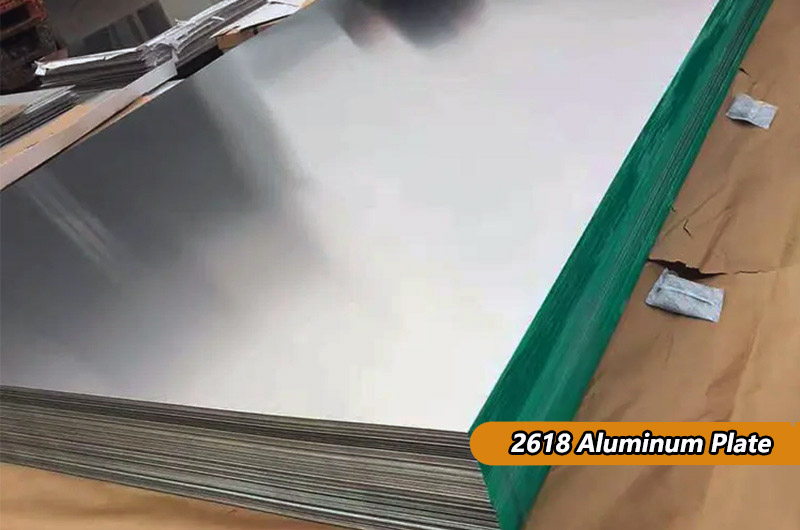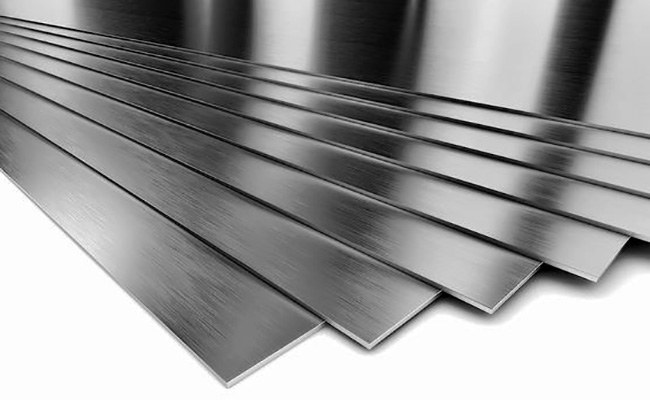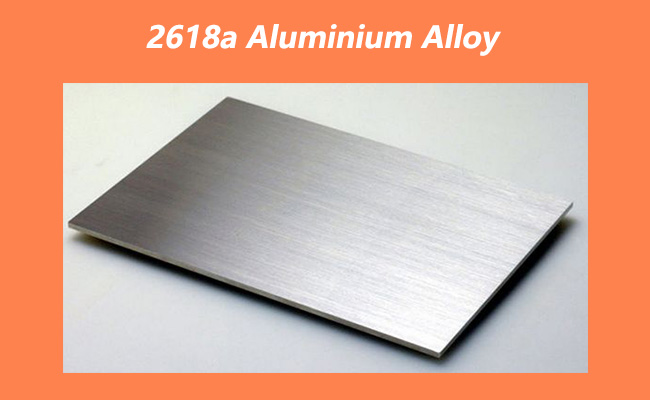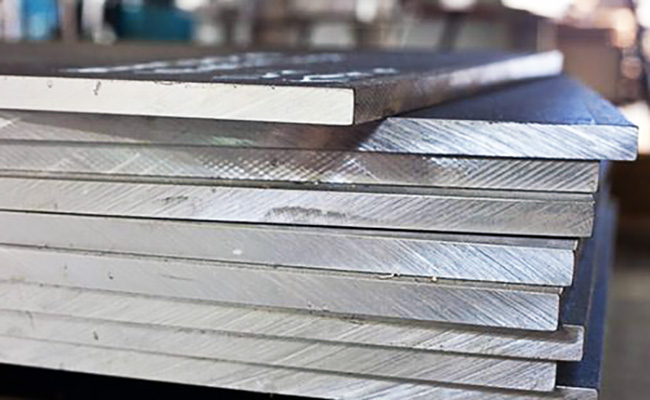2618 Aluminum Plate
Temper: T6/T61/T651 suitable for high temperature/high stress
What is Aluminum Grade 2618?
2618 aluminum is a high-strength aluminum alloy primarily used in applications requiring excellent mechanical properties, especially in high temperature and high stress environments. It is commonly used in aerospace and military applications as well as internal combustion engine components.
2618 aluminum plate is a high-strength aluminum alloy plate with excellent mechanical properties and high temperature resistance. This alloy is commonly used in applications in high-temperature environments, such as aerospace and engine manufacturing.

2618A Aluminum (Aluminum 2618) is a highly ductile and strong aluminum alloy containing both copper and magnesium. Alloy 2618A has good corrosion resistance, good machinability, and the ability to absorb large amounts of extreme heat with minimal damage. These properties make Aluminum Alloy 2618A (Aluminum 2618) an excellent metal for use in aerospace and defense components and high-performance automotive sports applications.
2618 aluminum alloy has excellent strength and hardness while maintaining stable performance at high temperatures. It is commonly used to make high-pressure cylinders, pistons and other parts that need to withstand high temperatures and pressures. 2618 aluminum plate also has good corrosion resistance, allowing it to perform well in various harsh environments.
- 2618A is a variant of 2618 aluminum alloy that has excellent high strength and is suitable for applications requiring high strength and heat resistance.
- 2618A aluminum alloy has good high temperature resistance and is suitable for manufacturing parts working in high temperature environments.
- 2618A aluminum alloy has good corrosion resistance and can maintain stable performance in harsh environments.
2618A aluminum plate standard
- Aluminum 2618 T61 AMS 4132 Forged plate
- Aluminum Alloy DTD 5070B 2618-TF Clad Sheet
- AIMS 03-04-036 Aluminum 2618A H28(T62) clad sheet
- BAEM 4049 Aluminum 2618A F(T62) clad sheet
- EN 2123 Aluminum 2618A T351 T851 plate
- 3.1924 Aluminum 2618A T651 plate
- DTD 5070 Aluminum 2618A T6 cladding sheet
2618 Aluminum Plate Characteristics
- High heat resistance, operating temperature range is 200-300°C.
- Good hot and cold processing properties, excellent ductility, moderate welding properties.
- Good machining performance and good resistance to atmospheric erosion.
- Has excellent strength and good corrosion resistance.
It has good machinability and good corrosion resistance under atmospheric conditions. Components subject to high operating temperatures benefit from the performance characteristics of 2618A.

2618 Aluminium Alloy Thick Sheet Specifications
| Alloy Series | 2series |
| Alloy | 2618 |
| Temper | T351 T651 |
| T (MM) | max.250 mm |
| W(MM) | max.3300 mm |
| L(MM) | max.38000 mm |
2618 Aluminum Product Forms
2618 aluminum alloy generally comes in many forms, including sheets for structural and mechanical components.
- 2618 Aluminum Sheet
- 2618 Aluminum Plate
- 2618 Aluminum Bar
- 2618 Aluminum Round Bar
- 2618 Aluminum Flat Bar
- 2618 Aluminum Rectangular Bar
- 2618 Aluminum Rod
- 2618 Aluminum Rolled Rings
- 2618 Aluminum Forged Rings
- 2618 Aluminum Disc
- 2618 Aluminum Extrusion
- 2618 Aluminum Extrusion angles
- 2618 Aluminum Billet
- 2618 Aluminum Ingot
- 2618 Aluminum Machined Parts
2618 Aerospace Grade Aluminum Forging
Aerospace-grade aluminum forgings made from 2618 alloy are used in a variety of critical components in aircraft, spacecraft, and other aerospace applications. The manufacturing process of forgings involves shaping aluminum into the desired shape through controlled heating and compression.
These forgings can be used for parts such as landing gear components and structural components that require high strength and heat resistance.
2618 2618A Aerospace Grade Aluminum Sheet Plate
2618A 2618 aviation aluminum plate has the characteristics of high strength, high corrosion resistance, high machinability and high thermal stability. It is widely used in manufacturing aircraft structures, turbine engines, rocket engines and other components.
2618 Aircraft Aluminum Rod
Aerospace-grade aluminum rods made from 2618 alloy are used in a variety of aerospace and aircraft applications. These rods are commonly used to construct structural components, supports, and other components that require high strength, high temperature resistance, and durability.
2618 Aluminum Pistons
2618 aluminum pistons are commonly used in high-performance and racing engines and certain aerospace applications. These pistons are designed to withstand the high temperatures and pressures found in internal combustion engines. They are known for their excellent strength-to-weight ratio, heat resistance, and durability. Aluminum's lightweight properties help reduce reciprocating mass, helping to improve engine efficiency and performance.

2618 Aluminum Mechanical Properties
| Property | Typical Value |
|---|---|
| Tensile Strength | 360 - 400 MPa (52, 000 - 58, 000 psi) |
| Yield Strength | ≥ 280 MPa (41, 000 psi) |
| Elongation at Break | 8% - 10% |
| Brinell Hardness (HB) | 95 - 110 HB |
| Fatigue Strength | Excellent |
| Modulus of Elasticity | ~70 GPa (10, 000 ksi) |
| Shear Strength | ~240 MPa (35, 000 psi) |
| Impact Strength | Good |
2618 Aluminum Plate Performance
Machinability
AL 2618 has excellent processing characteristics. Heat treated (aging) conditions produce a smoother finish than annealed or water quenched conditions.
Forming
2618 aluminum has good hot formability and cold formability.
Welding
Resistance welding can be accomplished satisfactorily. The heat input from other welding methods may be harmful to the alloy, so traditional fusion welding methods should not be used.
Heat treatment
Solution heat treatment is performed at 985 F for a period of time to allow for thorough heating and solution. For heavy duty sections this could be up to 24 hours. This heating is followed by water quenching. Annealing and age hardening heat treatments are also possible.
Forging
Hot forging is performed in the 970°F to 700°F range by first preheating the material to 970°F.
Thermal processing
2618 aluminum alloy can be easily hot-worked in a temperature range of 660 to 700 F.
Cold working
2618 aluminum alloy has good formability and is easy to cold work under solution heat treatment or annealing conditions.
Annealing
Cold working may require annealing at 725°F for 4 hours followed by slow cooling (usually furnace cooling).
Ageing
Aging Heat Treatment (T 61) First solution at 980 F for up to 24 hours (depending on cross-section size), then quenched in boiling water, then aged at 390 F for up to 20 hours (again at least 5 hours) depending on cross-section size ) and air cooling.
Tempering
Not suitable for 2618 aluminum alloy
Hardening
Hardened by cold working and aging heat treatment to T 61 conditions. See "aging."
2618 aluminum plate uses
- Aerospace field: 2618A aluminum alloy is often used to manufacture aircraft engine parts, spacecraft structural parts, high-temperature components, etc. due to its high strength, heat resistance and lightweight properties.
- High-performance engines: 2618A aluminum alloy is also commonly used in the manufacture of high-performance engines, such as racing engines, motorcycle engines, etc., to meet the requirements for strength and high temperature resistance.
- Military equipment: 2618A aluminum alloy is also widely used in the military field, including the manufacturing of high-strength and high-temperature components such as missile engine parts and fighter aircraft structural parts.
2618 Aluminum Processing
2618 aluminum is solution treated and artificially aged to achieve T6 condition, or controlled stretching is added to achieve T6511 condition. The maximum operating temperature of 2618A can reach 300°C, and it can still maintain its mechanical strength well at around 200°C and above.
- 2618A aluminum can be welded using resistance welding techniques.
- Alloy 2618 can be heat treated at 530°C (985°F) for a sufficient time and then quenched in water.
- 2618 aluminum alloy is forged at temperatures from 372 to 522°C (700 to 970°F).
- 2618 aluminum alloy can be hot worked at temperatures of 350 to 372°C (660 to 700°F) and can be cold worked in heat treated or annealed conditions.
- Annealing of 2618 aluminum can be performed at 385°C (725°F) for 4 hours.
Heat treatment process steps of 2618A aluminum alloy
1. Solid solution treatment
- Heating: Heat the 2618A aluminum alloy parts to the solid solution temperature, usually between 480°C and 530°C, and keep it for a certain period of time to ensure that the alloy elements are evenly distributed in the aluminum base.
- Insulation: Keep the alloy at the solid solution temperature for a certain period of time to allow the alloy elements to fully dissolve in the aluminum base and eliminate the intensity inhomogeneity at the grain boundaries.
- Cooling: Rapid cooling (usually water quenching) to fix the distribution of alloy elements in the aluminum base and avoid the precipitation of excessive precipitation phases.
2. Timeliness treatment
- Aging treatment: Heat the solution-treated 2618A aluminum alloy parts to the aging temperature, usually between 160°C and 190°C, and keep it for a certain period of time.
- Aging: Keep it for a certain period of time to allow the precipitated phase to precipitate between the grains and improve the hardness and strength of the alloy.
- Cooling: According to specific requirements, the alloy after aging is appropriately cooled.
2618A 2618 Aluminum Plate Chemical Composition
| Weight% | Alloy 2618 USA | Alloy 2618A EAA |
| Al | Rem | Rem |
| Si | 0.10-0.25 | 0.15-0.25 |
| Fe | 0.9-1.3 | 0.9-1.4 |
| Cu | 1.9-2.7 | 1.8-2.7 |
| Mn | - | 0.25 max |
| Mg | 1.3-1.8 | 1.2-1.8 |
| Ni | 0.9-1.2 | 0.8-1.4 |
| Zn | 0.10 max | 0.15 max |
| Ti | 0.04-0.10 | 0.20 max |
| Zr + Ti | - | 0.25 max |
| Other Each | 0.05 max | 0.05 max |
| Others Total | 0.15 max | 0.15 max |
2618a Aluminum Alloy
Aluminum alloys 2618 and 2618A are similar, but they also have differences, mainly related to their composition and properties. Here are the main differences between the two:
2618a Aluminum Alloy Composition
Aluminum Alloy 2618A: The "A" designation usually indicates a modified or improved version of the alloy. The exact composition of 2618A may vary from manufacturer to manufacturer, but some alloying elements may be slightly adjusted to enhance specific properties.
What are the Properties of Aluminum 2618A?
2618A: The "A" designation indicates that it may have certain modifications to improve specific performance or characteristics. These modifications may include changes in strength, ductility, or other performance attributes.
2618a Aluminum Alloy Applications
2618 is a proven alloy used in demanding applications where strength, heat resistance, and fatigue resistance are critical.
2618A is typically developed as an improved or specialized version of 2618, and its applications may vary based on specific modifications to the alloy.
While 2618 and 2618A are both high-strength aluminum alloys used in demanding applications, the "A" designation indicates that 2618A may have changes in composition or properties compared to the standard 2618 alloy.

Typical 2618 Aluminum
2618 T6/T61/T651 Aerospace Grade Aluminum Components
Aerospace Components: 2618 is widely used in a variety of components in the aerospace industry, including
- 2618 aluminum for aircraft engine piston
- 2618 aluminum for aircraft connecting rod
- 2618 aluminum for aircraft structural parts
The high strength and high temperature resistance of 2016 aluminum make it ideal for these applications.
2618 Aluminum for Internal Combustion Engine Components
2618 aluminum alloy is commonly used to manufacture high-performance pistons and piston pins for internal combustion engines, especially high-performance and racing engines.
2618 Aluminum for High-Performance Racing
Due to its strength, heat resistance, and lightweight properties, 2618 aluminum is popular in racing applications, including high-performance engines and racing components.
2618A aluminum is popular in motorsports applications including racing engine components, pistons, chassis components and applications requiring better performance at higher temperatures.
2618 Marine Grade Aluminum Components
The corrosion resistance and excellent fatigue resistance of 2618 aluminum alloy make it suitable for marine applications, such as marine engine parts and marine components subject to high loads.
High-Stress Mechanical Components
Used for various mechanical components subjected to high stress, such as crankshafts, connecting rods, transmission components, and other industrial equipment in heavy machinery.
Pressure Vessels
Due to its strength and resistance to high pressure, 2618 is used in the manufacture of certain pressure vessels used in industrial processes.
Sports Equipment
In the manufacture of sports equipment, such as high-performance bicycle frames and components, lightweight materials with good strength are required.
2618 Automotive Aluminum for Components
While 2618 is more common in racing and high-performance vehicles, it may also be used in specific automotive parts that require high strength and high temperature resistance.
2618 Defense and Military Aluminum
Defense and Military: Various military applications, including the production of military vehicles and aircraft components.
Specific applications for 2618 aluminum alloy may vary based on manufacturer requirements, required properties of the part, and engineering considerations. This alloy is favored in applications where strength, heat resistance, and fatigue resistance are critical.

What is the difference between 4032 and 2618 Aluminum?
Aluminum alloys 4032 and 2618 are both high-strength aluminum alloys used in demanding applications, but they have differences in their composition and properties. Here's a comparison of these two alloys:
Composition
4032 Aluminum Alloy:
Aluminum (Al): Approximately 88.4%
Silicon (Si): Approximately 11.5%
Other Elements: Contains small amounts of iron (Fe), copper (Cu), manganese (Mn), magnesium (Mg), and other trace elements.
2618 Aluminum Alloy:
Aluminum (Al): Approximately 91.1%
Copper (Cu): Approximately 1.9%
Iron (Fe): Approximately 1.7%
Magnesium (Mg): Approximately 1.3%
Other Elements: Contains small amounts of zinc (Zn), manganese (Mn), silicon (Si), titanium (Ti), chromium (Cr), and trace amounts of other elements.
Properties
4032 Aluminum Alloy
4032 is often referred to as a silicon-aluminum alloy. It is known for its excellent wear resistance, which makes it suitable for piston applications in internal combustion engines. It also offers good thermal properties and is capable of retaining strength at elevated temperatures.
2618 Aluminum Alloy:
2618 is a high-strength aluminum alloy known for its strength, good corrosion resistance, and excellent fatigue resistance. It is used in high-stress and high-temperature applications, particularly in aerospace components and internal combustion engine pistons.
Applications
4032 is commonly used in applications where wear resistance is essential, such as pistons in internal combustion engines. Its silicon content provides improved wear properties.
2618 is used in applications where high strength, heat resistance, and fatigue resistance are critical. It is suitable for aerospace components and high-performance pistons.
The main difference between 4032 and 2618 aluminum alloys is their composition and resulting properties.
- 4032 is known for its wear resistance due to its higher silicon content, making it suitable for piston applications.
- 2618 is valued for its high strength, good corrosion resistance, and fatigue resistance, making it suitable for demanding high-stress applications including aerospace components and internal combustion engine pistons.
The choice between these alloys depends on the specific requirements of the application.
People also searched for Aluminum Plate
-
2219 Aluminum Plate Sheet
2219 aluminum alloy is a high-strength alloy, high temperature resistant and good cutting processing and good mechanical properties. 2219 aluminum plates are in line with AMS QQ-A-250/30. Common TEMPER includes T31, T81, O, etc.
-
2017 Aluminum Plate Sheet
2017 aluminum plate is a heat-treatable forged aluminum product with good strength, ductility and good workability.
-
2024 Aluminum Plate Sheet
2024 aluminum is a prominent hard aluminum alloy in the aluminum-copper-magnesium series. 2024 aluminum plates are famous for their high strength and excellent fatigue resistance, as well as their ability to be easily processed and welded.
-
2024 t851 Aluminum Plate Sheet
2024 T851 aluminum is commonly used in aerospace and military applications, such as the construction of aircraft structural components, due to its excellent strength-to-weight ratio and fatigue resistance.
-
2024 T4 Aluminum Plate Sheet
2024 T4 aluminum has a high strength-to-weight ratio and good fatigue resistance, making it a popular choice for aerospace and structural applications. It also has good machinability and weldability, although it is not as corrosion resistant as some other aluminum alloys.
-
2024 T3 Aluminum Plate Sheet
2024 T351 aviation aluminum plate is a high-strength aviation aluminum alloy material. T351 has large surface and internal residual stress and good explosion impact resistance. 2024 t351 is one of the aviation aluminum alloys. It is widely used in skins, bulkheads and structural parts that need to withstand high cyclic loads on various aircraft.
People also searched for Aluminum Plate
-
2219 Aluminum Plate Sheet
2219 aluminum alloy is a high-strength alloy, high temperature resistant and good cutting processing and good mechanical properties. 2219 aluminum plates are in line with AMS QQ-A-250/30. Common TEMPER includes T31, T81, O, etc.
-
2017 Aluminum Plate Sheet
2017 aluminum plate is a heat-treatable forged aluminum product with good strength, ductility and good workability.
-
2024 Aluminum Plate Sheet
2024 aluminum is a prominent hard aluminum alloy in the aluminum-copper-magnesium series. 2024 aluminum plates are famous for their high strength and excellent fatigue resistance, as well as their ability to be easily processed and welded.
-
2024 t851 Aluminum Plate Sheet
2024 T851 aluminum is commonly used in aerospace and military applications, such as the construction of aircraft structural components, due to its excellent strength-to-weight ratio and fatigue resistance.
-
2024 T4 Aluminum Plate Sheet
2024 T4 aluminum has a high strength-to-weight ratio and good fatigue resistance, making it a popular choice for aerospace and structural applications. It also has good machinability and weldability, although it is not as corrosion resistant as some other aluminum alloys.
-
2024 T3 Aluminum Plate Sheet
2024 T351 aviation aluminum plate is a high-strength aviation aluminum alloy material. T351 has large surface and internal residual stress and good explosion impact resistance. 2024 t351 is one of the aviation aluminum alloys. It is widely used in skins, bulkheads and structural parts that need to withstand high cyclic loads on various aircraft.

